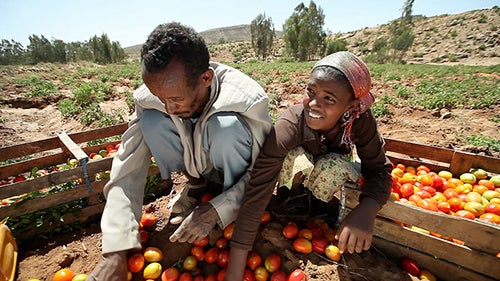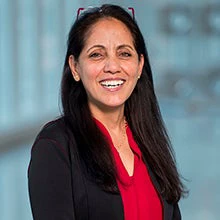
Agriculture and nutrition share a common entry point: “food.” Food is a key outcome of agricultural activities, and, in turn, is a key input into good nutrition. Without agriculture there is little food or nutrition, but availability of food from agriculture doesn’t ensure good nutrition. Common sense would dictate a reinforcing relationship between the two fields of agriculture and nutrition but, in fact, there is often a significant disconnect.
Given that the genesis of agricultural development was to provide food “adequate for the health and strength of all people,” it seems reasonable to expect that among the top priorities of agriculture would be to look beyond just calories to ensure feeding people well. Likewise, it would seem that the field of nutrition should be closely connected, if not synonymous, with food consumption.
Yet most practitioners in food and nutrition would consider these characterizations a limited description of their work.
Evidence shows that nutrition is about much more than food availability; it encompasses access to food at the household level, health services and a healthy environment and adequate child caring practices. Most agriculturalists do not consider the main goal of agricultural development to be the improvement of human health, beyond providing sufficient calories, but rather a broader agenda recognizing the important role that agriculture plays as a major livelihood and driver of economic growth in countries.
With the exception of the 1960s and 70s, when hunger and famine were key global policy issues, a unified push to address nutrition problems, explicitly through food has been absent from both sectors.
We now have new opportunity to bridge that gap. Earlier today, the World Bank released a visionary report titled, “Ending Poverty and Hunger by 2030: An Agenda for the Global Food System.” The report calls on key partners and alliances to come together to shape the evolution of the global food system to end poverty and hunger by 2030. More specifically, it calls for stronger focus on climate-smart agriculture, improving nutritional outcomes, and building more inclusive and efficient food value chains.
The report forges a strong connection between agriculture and nutrition which is vitally needed. Undernutrition remains a daunting challenge worldwide and a stubborn barrier to ending poverty. It is the underlying cause of 45% of under-5 child deaths each year, and about one in three children in developing countries are stunted. Stunting is an especially pernicious problem, leading to long-term, harmful effects on physical and intellectual development, as well as lower income-earning potential over a lifetime, which compromises future human capital and holds back productivity (including agricultural productivity) and economic growth.
To bridge the disconnect between nutrition and agriculture, we need to work together across sectors to create a global food system that is sensitive to nutritional outcomes. The World Bank Group has made headway here: In 2012, about 12% of agriculture projects included nutrition-sensitive elements. In 2014, this number jumped to 19%. The new GAFSP project in Uganda brings together agriculture, health and education sectors to find solutions to persistent undernutrition. And there are many other examples too.
We need to continue to make the case that agriculture has a unique and critical role in improving nutritional status. Three linking factors deserve particular attention:
First, agriculture has the most direct influence and contact with the majority of households where undernourished individuals reside worldwide. Beneficiaries of typical agricultural projects overlap with those most affected by undernutrition: the rural poor. Seventy-eight percent of the world’s poor are rural, and most of those are smallholder farmers. Any development activity reaching this population has enormous potential to influence factors that constrain human capital and well-being, of which nutrition is an essential part. For example, agriculture extension workers have direct and ongoing contact with smallholder farmers, and therefore have a unique opportunity to strengthen messages regarding not just production, but also consumption of nutritious foods, including bio-fortified crops, especially by vulnerable groups, including pregnant women and young children.
Second, agricultural-led growth is more pro-poor than non-agricultural-led growth, thereby increasing agriculture’s potential to improve nutrition. Agricultural growth is at least twice as effective in reducing poverty as GDP growth originating outside agriculture and is therefore pro-poor. Agriculture-led growth has led to faster (though still insufficient) declines in undernutrition than non-agricultural growth in many countries, albeit there are exceptions to this, as in the case of India.
Third, agriculture is the sector best placed to affect food production and consumption of nutritious foods needed for healthy and active lives. Physical and economic access to adequate and affordable nutritious food is primarily a function of the agriculture sector, through support to increased production, improved post-harvest storage and processing (including food safety issues such as aflatoxin control), and reduced transport costs which can lower food prices for poor consumers. Agriculture does not directly influence consumer demand but can help make nutritious food available to consumers at affordable prices.
Undernutrition is one of the world’s most serious, but least addressed, public health challenges, with more than 162 million stunted children in developing countries. As the world moves toward the new Sustainable Development goals, country and development partners will need to step up progress on child health and nutrition outcomes to enhance both human and economic development prospects. A stronger nutrition-agriculture alliance will give us a head start.
Follow the World Bank health team on Twitter: @WBG_Health
How do we build a food system that feeds –and nourishes--everyone, everyday, everywhere? We’re opening up the conversation on the future of food to new ideas. Watch a replay of an April 16 World Bank’s April 16 webcast on the Future of Food, and join the conversation with #food4all.
Related
Ending Poverty and Hunger by 2030: An agenda for the global food system
World Bank Live Webcast: Power of Nutrition
New fund targets billion dollars for children’s nutrition


Join the Conversation